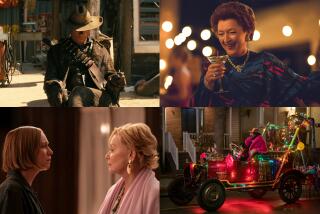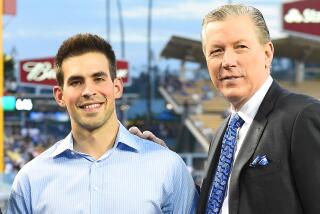YEAR IN REVIEW 1995 : Where Big Is Not Necessarily Better : TV’s bloated year saw mega-mergers, plummeting news quality--and then there was Newt’s mom.
Title 1995 television’s year of the colossus, a salute to corporate obesity in which things large promised to get larger, with control of these swollen wide-bodies of communications narrowing to an alarmingly select few.
Even as its power was expanding, the crowd at the top was thinning. Walt Disney Co. announced a $19-billion deal to acquire Capital Cities/ABC, Westinghouse Electric Corp. completed a $5.4-billion acquisition of CBS and Time Warner Inc., and Turner Broadcasting System agreed to a monster of all mergers that would make other cable operators look almost like mom-and-pop ventures.
This sprawl offered the prospect of incestuously interlocking empires--something akin to the blood mixing of European royalty--and growing potential for conflicts of interest.
Oh, profiting stockholders were in their cups, Ted Turner was publicly euphoric, and word at CBS, for one, was that any change there was welcome given years of unenlightened ownership by Laurence A. Tisch. Yet if its trashy 3-month-old series “Day & Date” even faintly represents the Brand X journalism that Westinghouse hopes to stamp on CBS News, watch out.
In any case, it was not immediately apparent at year’s end just how the public stood to benefit directly from any of these multibillion-dollar alliances, which would further consolidate clout and influence.
Meanwhile, ABC News announced plans to create a 24-hour cable news channel to compete with entrenched CNN. NBC and giant Microsoft Corp. formed a partnership to do the same thing. And Congress wrestled with an intricate tangle of complex proposals to reform the nation’s 1934 communications law, largely through deregulation.
*
What couldn’t be fixed by legislation or additional news channels, though, was another metastasizing cancer.
Media cynicism.
It, too, spread pervasively in 1995. The phenomenon’s ear-splitting, eye-stinging metaphor was leering, sneering, rarely endearing coverage of the O.J. Simpson case, which found a vast, eclectic array of reporters and other news-related wise guys, from the solid to the sordid, still hurtling toward this wrong-way Bethlehem Star, at once guided by it and blinded by it.
The descent had begun years earlier and continued into the early ‘90s. Yet this was the year, after a lowly 1994, that news quality and integrity at last drained to the bottom of the hourglass. The biggest story was not only the Simpson case but also how it became the biggest story, mostly through unabated media pounding and hyperbolic, inflammatory, knee-jerk, anything-goes, get-it-on-the-air-and-think-about-it-later TV reporting designed to match the tabloids tease for tease, titillation for titillation, destructiveness be damned.
Nor was this an isolated event but rather an extension of newscasting’s dangerously myopic focus on crime and conflict--If it doesn’t shout, leave it out!--to the exclusion of nearly everything else. The result: more disposable and fear-feeding information from TV, less enlightenment--all in the interest of dazzling Americans with showy fireworks and tapping their basest instincts.
Even after the Simpson case ended, its over-the-top coverage was transferred to other stories and other TV components as, throughout the typical broadcast day, traditional boundaries were erased and one program seemed to bleed into another. How different is TV’s prevalent news product, for example, from the insidious din of daytime talk shows that in 1995 were publicly excoriated by some of the nation’s high and mighty, not only for being salacious but also for giving undeserved fame to society’s misfits and mutants, and by doing so distorting America’s view of itself?
What better evidence of cynicism than the lawsuit-fearing “Jenny Jones” talk show rejecting even a shade of contrition after Jon Schmitz fatally shot fellow guest Scott Amadure, three days after the taping of a secret admirer segment in which the victim-to-be revealed that he had a crush on Schmitz? Instead of jamming on the brakes, the “Jenny Jones” incident fueled an even higher-octane surge of such humiliation and ambush themes on other talk shows, which were equally determined to show no quarter when playing Russian roulette with lives.
The year offered many more notables, though:
Biggest Case of Overexposure: It’s not easy overshadowing that frizzed, shrieking, hammy, weepy weight maven Richard Simmons. Or Gloria Allred, the Los Angeles attorney who can sniff a TV camera in the next county. Or writer Dominick Dunne, the lippy trial fanatic who may have logged more time in front of TV cameras during the Simpson case than Ms. Marcia and Mr. Johnnie combined. Or Kato Kaelin and other profiteering symbols of O.J. mania. Or tenaciously perky (when she’s not publicly slamming her own show) Kathie Lee Gifford. Or House Speaker Newt Gingrich, for whom the camera has little affection despite his persistent efforts to make it his pal.
But face it, this was Martha Stewart’s year. Even beyond her regular gigs on NBC’s “Today,” she somehow wound up being television’s designated tulip, the obsessively orderly and functional lifestyle counselor cluing in the unenlightened on achieving personal fulfillment through table setting, flower arranging and micro-managing of things superficial. Her sprouting as national guru is baffling, for what’s said about some politicians appears to apply to her: There’s no there there. Will Mother Martha please pack up her bulbs and take a long vacation?
Biggest Crybaby: Rep. Enid Greene Waldholtz, the Utah Republican, who, in a recent televised press conference of nearly five hours, carried live on C-SPAN, poured more tears than Tammy Faye Bakker while again blaming the shady financial scandal engulfing her on her estranged husband and her own alleged naivete. What was a trusting little wife to do? Skeptics point out, however, that she’s also as tough as Bakker.
Most Over-Covered: Making a run for this honor was Gingrich’s mom confessing to Connie Chung that her son had called First Lady Hillary Clinton a bitch, a taped tidbit that CBS News nastily delayed airing so that it would coincide with Gingrich formally assuming the speakership. Well, what was the big deal? Why should anyone care what Gingrich says inprivate about Hillary any more than what he says about Bill? Do that many Americans still believe that it’s somehow not gallant for males to say impolite things about “helpless” females? Sure, Hillary Clinton is real helpless.
Also right up there was the death of Linda Sobek, the model who was virtually unknown until the media arbitrarily granted her alleged murder precedence over other mayhem-related deaths in Los Angeles, in effect valuing her life over those of other victims.
But the winner is the very nice but grossly overemphasized Capt. Scott O’Grady, the downed U.S. airman anointed a hero for surviving in hostile Bosnian territory until getting rescued by colleagues. Staying alive is what we all try to do instinctively, right? Just why doing what comes naturally confers hero status in this case remains mysterious. Perhaps there’s something spiritual about keeping hidden and eating bugs. Perhaps not.
O’Grady got a book out of it, though, and spent some of December hitting the talk show circuit to advertise it. Where are the book deals for those who risked their lives to bring him out?
Overblown Controversy: Chung’s removal, leaving the anchorship of “The CBS Evening News” in the iron grip of Dan Rather. Chung got the co-anchor job in the first place because of her camera presence--her reputation for charming viewers with her personality--not because of her journalism. So she shouldn’t complain about being dropped for equally shallow reasons.
Arguing that Rather instead of Chung should have taken the fall for the news program’s low ratings, her supporters read sexism in her removal, saying it proved that males still get preferential treatment in the industry. When it comes to Chung, at least, what a load!
Label this a case of misplaced admiration. Chung did nothing to earn the mantel of heroine or role model. The real heroines of TV journalism are field reporters with tough, critical news beats, not the least of whom are CNN’s Christiane Amanpour and ABC’s Sheila MacVickar, London-based correspondents who have slogged it out in harm’s way with U.S. troops in cold, snowy Bosnia instead of reading a TelePrompTer inside a cozy studio. The more they’re seen, the greater their credibility.
Phoniest Argument Against Change: Is it really true, as some of its critics insist, that the proposed V-chip--a gizmo that, under legislation pending in Congress, would be mandatory in new TV sets--would amount to censorship by allowing parents to block programs they deem too violent for their children? Sure, if you believe that parents should not be the final arbiters of what their kids watch on TV.
Why, this could lead to tyranny. Let’s hear it for toddlers’ rights!
Most Spectacular Sight: The blanket of black filling the camera’s eye during the remarkable Less Than a Million Man March at the nation’s capital, organized by Nation of Islam leader Louis Farrakhan.
Most Shattering Sight: The carnage of humanity and real estate, and the despair and disbelief on the faces of some survivors and rescue workers, captured by cameras in the immediate, chaotic aftermath of the Oklahoma City bombing, that rare story that eclipsed Simpson coverage.
Most Moving Events: The televised memorial services for Oklahoma City bombing victims and for assassinated Israeli Prime Minister Yitzhak Rabin.
Best Prime-Time Trend: The cloning of NBC’s “Friends.” It’s specifically stated in TV’s contract with America that everything successful gets copied. Gotta happen. So be thankful, at least, that this season’s prevalent prototype is a very funny, very smart comedy whose ensemble characters wear well. Having more of them isn’t such a bad idea. Think of worse scenarios--that instead of “Friends” it was ABC’s “America’s Funniest Home Videos,” for example, that was echoing across prime time.
Worst Prime-Time Trend: The mass cloning of “Friends.” A few copies, all right. But everywhere “Friends”? Get a grip!
Worst Commercial: On the theory that good commercials are an oxymoron, we rush to the negative, right to those disgusting Carl’s Jr. spots that sell burgers by showing diners slobbily squirting juices as they eat. What’s next, showing food inside their mouths? As it was, you needed an oversized umbrella even in your living room to avoid getting drenched by these massive spritzings--which was somehow appropriate in the year of the colossus.
More to Read
The biggest entertainment stories
Get our big stories about Hollywood, film, television, music, arts, culture and more right in your inbox as soon as they publish.
You may occasionally receive promotional content from the Los Angeles Times.










